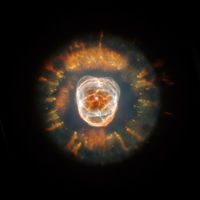Eskimo Nebula
 From Conservapedia
From Conservapedia | Eskimo nebula | |
|---|---|

| |
| Observational Data | |
| Designation | NGC 2392 Cadwell 39 |
| Right ascension | 07h 29m 10.7669s[1] |
| Declination | +20° 54′ 42.488″[1] |
| Constellation | Gemini |
| Type of object | Planetary nebula |
| Dimensions | 48x48 arcseconds |
| Magnitude | Apparent Mag: +10.1[1] Absolute Mag: ≤+0.4[1] |
| Redshift | 0.000281±0.000007[2] |
| Astrometry | |
| Distance from Earth | ≥2,870 ly[1] |
| Radial velocity | 82.2±2 km/s[2] |
| Proper motion | RA: -3.97 mas/yr[2] Dec.: 1.59 mas/yr[2] |
| Parallax | 5.60±3.75[2] |
The Eskimo nebula (NGC 2392, Cadwell 39) is a planetary nebula in the constellation of Gemini, the Twins.[1] The nebula's similar appearance to a face surrounded by a fur-lined parka has lead to it being called the "Eskimo nebula" and sometimes the Clown Face nebula. The nebula cannot be seen with the naked eye but can just be made out with binoculars or a small telescope. Through larger telescopes, the central star can be made out and the nebula has a green appearance. The nebula was first observed on January 17, 1787 by William Herschel.[3] He described it as a 9th magnitude star surrounded by equal nebulosity in all directions.
Properties and Structure[edit]
The exact distance to the nebula is unknown, but it is thought to be at least 2,870 light years away.[1] This uncertainty in its distance means its apparent size of 48 x 48 arcseconds corresponds to a physical radius of at least 0.34 light years.[3] The nebula is approaching Earth at 82.2 km/s.[2]
The nebula possesses a complex structure consisting of various shells and streamers of gas surrounding a central star.[4] These are so complex that they are not fully understood.[5] Images from the Hubble Space Telescope have demonstrated that the inner structure is believed to have been formed by the outpouring of radiation from the central star pushing a bubble of gas outwards. The outer region contains extremely long filaments of material, some are around a light year long.[5] The nebula also contains "cometary knots," also seen in other planetary nebulae such as the Helix nebula and Dumbbell nebula.
A study performed using the Chandra X-ray Observatory has observed higher than usual x-ray emission from the nebula.[6] Two other nebulae that were investigated, the Spirograph nebula and NGC 6826, and both had lower x-ray emissions. It has been suggested these higher emissions are due to an unseen star orbiting the star that is visible, making it a binary system.[6] The interaction of the two stars would explain the additional x-ray radiation. In the other nebula, x-rays are only produced by shock fronts in the stellar wind created by the central stars in those nebulae.[6]
References[edit]
- ↑ 1.0 1.1 1.2 1.3 1.4 1.5 1.6 Eskimo Nebula – NGC 2392 from constellation-guide.com
- ↑ 2.0 2.1 2.2 2.3 2.4 2.5 NGC 2393 from simbad.u-strasbg.fr
- ↑ 3.0 3.1 NGC 2392 from freestarcharts.com
- ↑ The Eskimo Nebula (NGC 2392) from esa.int
- ↑ 5.0 5.1 Eskimo Nebula from nasa.gov
- ↑ 6.0 6.1 6.2 NGC 2392 from chandra.harvard.edu
| ||||||||||||||||||||
Categories: [Astronomy] [Nebulae]
↧ Download as ZWI file | Last modified: 02/16/2023 01:25:40 | 4 views
☰ Source: https://www.conservapedia.com/Eskimo_nebula | License: CC BY-SA 3.0
 ZWI signed:
ZWI signed: KSF
KSF